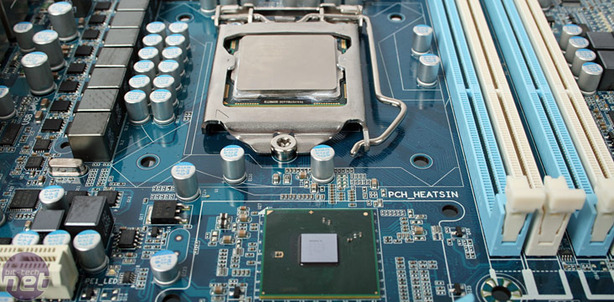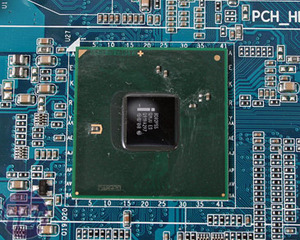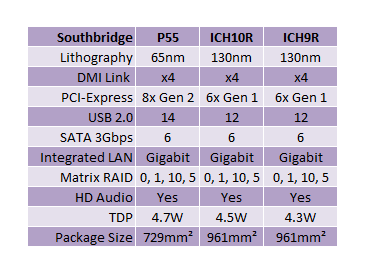
Intel P55 PCH
With the new LGA1156 socket comes a new chipset too - there is no upgrade path from current Intel P45 or X58 products, instead you have to buy a new P55 motherboard to accompany Lynnfield CPUs. Intel's P55 chipset is a single chip, unlike the chipset+Southbridge combinations of previous motherboards.Connection to the P55 chipset is simply by the standard DMI link all Intel inter-chipset communications use. This effectively makes P55 a glorified Southbridge. The difference between ICH10R and P55 is about as huge and exciting as the evolution from ICH9 to ICH10 - that's not very exciting at all, just in case you haven't been paying attention to Southbridge technologies over the years.
Physically P55 is different, because for the first time Intel has a flipchip "southbridge", with the core of the chip exposed to directly connect to the heatsink above. The lithography has shrunk it down from 90nm to 65nm, and the overall size is smaller too - and that's even before we take into account that previous Southbridges required a complementary Northbridge. With P55 taking less board space than any previous Intel chipset, we'll hopefully see some unique mini-ITX and SFF motherboards, and perhaps even mini-ITX boards with 16x PCI-E slots.
P55 has eight PCI Express lanes to offer, an increase over previous Southbridges, but you shouldn't expect every motherboard to have a tertiary 8x graphics slot. Some of these PCI-E connections will inevitably used for onboard peripherals such as FireWire and Gigabit Ethernet controllers. However, Intel already provides native PHY Gigabit Ethernet and Firewire chipsets that use a legacy PCI connections, so we shouldn't rule it out.
We've already seen boards with 4x PCI-E slots, but these still won't run 3-way SLI or triple-card CrossFire, as the signal sources for the primary and secondary slots will be different from the tertiary slot - the CPU feeds the first two while the

Intel has been decidedly sneaky in its marketing of the PCI-E capabilities of P55, though. Intel says that P55 supports 'Generation 2' PCI Express, which usually operates at 5GT/sec for an 8x slot. Intel disputes this, claiming "The PCI-E ports on P55 support the PCI Express 2.0 spec at the 2.5 GT/sec speed. The 5GT/sec speed (which is often referred to as Gen 2) is an optional component of the PCI-E 2.0 spec and is not supported on P55."
We asked Intel what exactly made the PCI-E connections of P55 'compliant' with the Generation 2 specification, but have yet to receive a precise response. Even if Intel is classing it as 'working with Gen 2 devices', PCI Express is designed to be backward compatible, so we can just as easily say that the PCI-E lanes of P55 are actually PCI-E 1.1 connections. But we'll wait to hear from Intel before catagorically saying that.
Included in P55 are six SATA 3Gbps connections, with the usual Matrix RAID for 0, 1, 0+1 and 5 support. There's also the standard Azalia High Definition audio specification we're used to so that l motherboard companies can license Dolby and DTS effects on top of this, with Dolby specifically releasing additional PC software for HD media later this year.


MSI MPG Velox 100R Chassis Review
October 14 2021 | 15:04










Want to comment? Please log in.